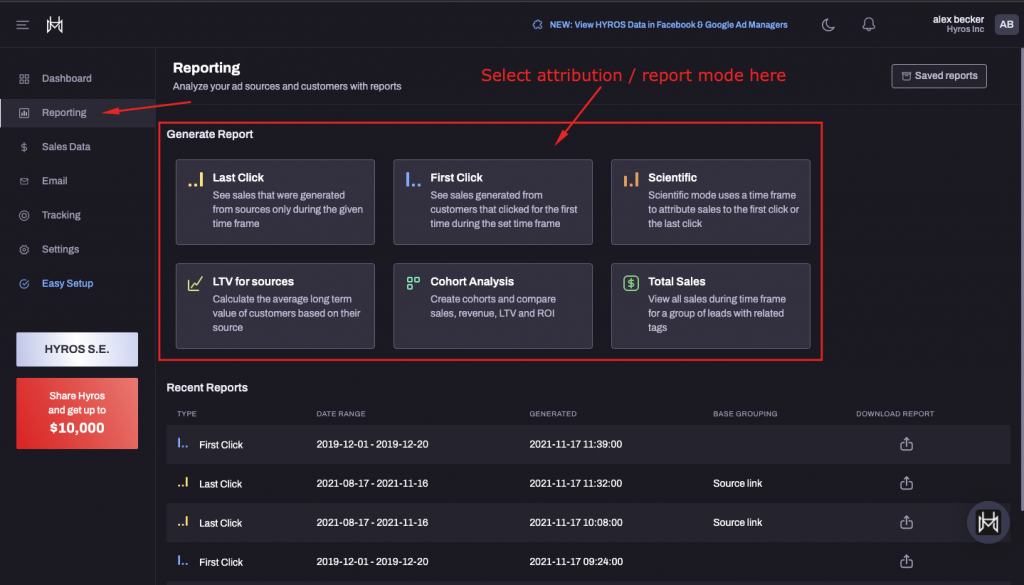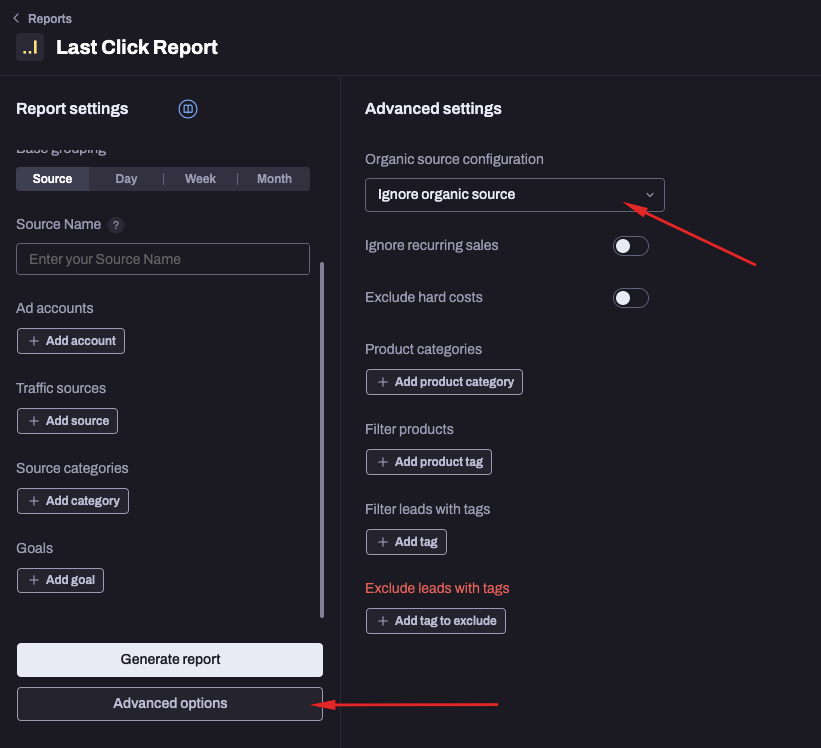Using HYROS Attribution Modes
HYROS has many different attribution modes to allow you to view your data from multiple angles. These models are selected when you load up reports under REPORTING-> REPORTS in the HYROS dashboard.
Attribution models determine which source should receive credit for a sale and give different perspectives on how sales are created. For example, LAST CLICK mode will always give the sale credit to the last source clicked. While FIRST CLICK/SEEN model will track all sales that have originated from a source clicked in a certain time frame.
Using Attribution Models
Using different attribution models is easy. To select an attribution mode, simply go to “reporting” and select your attribution mode as shown:

Then after selecting your desired date range and filters hit “Generate Report”.
Attribution Models Explained
If you look at the sidebar to the left of this guide you will see attribution models and deep explanations of each attribution model and how to use them if needed.
Here is a brief summary of each model.
Last Click – This model will assign the sale to the last source that was clicked. It has the generic mode which will assign the sale on the date of sales and DATE OF CLICK mode that will assign the click to the date of the click. This is a bread and butter simple way to track your customers. Click HERE to read more about last click attribution.
First Click – This model will do exactly the same thing as Last Click, but will assign the sale to the first source that was clicked. It has the generic mode which will assign the sale on the date of sales and DATE OF CLICK mode that will assign the click to the date of the click. This is a very easy way to understand which front end sources are bringing in revenue.
Scientific Mode – Scientific mode allows you to set time on first click attribution. For example, if the mode is set to 30 days any sales generated within 30 days of the first clicked source will go to the first clicked source. Any sales after 30 days will go to the last clicked source. This mode works great for webinar and sales call funnels or funnels with long click to sale cycles. Click HERE to read more about scientific attribution.
Multi Touch Attribution Models – These will allow you to spread attribution across multiple clicks to understand how each source is working together.
This is especially useful for funnels where leads often go through complex journeys including multiple sources. Currently, these are the multi-touch modes that we have available:
- Depreciation Mode – Applies the most credit to the most recent click (the last click), use this if you consider the last click before the sale the most important but still want to understand how previous clicks may be contributing to the final sale.
- Fractional Linear Reporting – Attributes all sources equally. Use this if you consider each source equally as important throughout a user’s journey, or want to understand how often buyers click through certain ads throughout their journey, regardless of if the ad is the first or last click.
Click HERE for more information on our multi-touch attribution reporting.
LTV – This is calculated in a number of ways. Click HERE to read more about the different LTV mode reports that we offer. Here is a summary of the reports that will allow you to view the LTV and answer different questions:
- First Click LTV is a very interesting mode that calculates all the sales of a customer that originated from a source in a given time frame. For example, it will take all users that entered your business through a source from Oct 1 to Oct 5 and show you the total amount of sales they’ve generated since entering.
- LTV for sources will look at all the users that originated from each source and calculate the average customer value over a specified time frame.
- LTV for a segment will calculate the average LTV for a specific group of leads over a specified time frame.
- Cohort analysis will allow you to compare the LTV of specific groups of leads who entered your system at different times.
Organic Sources
For most attribution modes you have the option of choosing to include ad traffic only, organic traffic only, or both together.
This is very important in attribution because organic sources in Hyros, such as email sources, can often take credit for sales and make your ad traffic appear to be underperforming.
This is the most common case, and therefore by default organic sources are ignored inside the reports, to change this go to the advanced configurations when loading a report:

To read more about organic sources see HERE. As you can see, there are other advanced filtering options we can use which are covered in our organization sections, but this section covers the basic attribution modes and how they work.